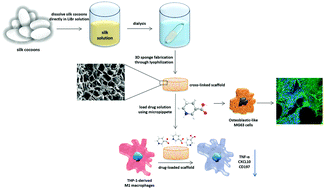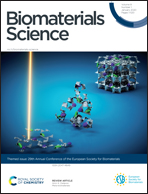Silk based scaffolds with immunomodulatory capacity: anti-inflammatory effects of nicotinic acid†
Abstract
Implantation of temporary and permanent biomaterials in the body leads to a foreign body reaction (FBR), which may adversely affect tissue repair processes and functional integration of the biomaterial. However, modulation of the inflammatory response towards biomaterials can potentially enable a favorable healing response associated with functional tissue formation and tissue regeneration. In this work, incorporation of nicotinic acid in 3D silk scaffolds is explored as an immunomodulatory strategy for implantable biomaterials. Silk scaffolds were fabricated from dissolved Bombyx mori silk fibers by freeze-drying, resulting in silk scaffolds with high porosity (>94%), well-connected macropores, a high swelling degree (>550%) and resistance to in vitro degradation. Furthermore, drug-loaded scaffolds displayed a sustained drug release and excellent cytocompatibility could be observed with osteoblast-like MG63 cells. Cultivating M1-like macrophages on the scaffolds revealed that scaffolds loaded with nicotinic acid suppress gene expression of pro-inflammatory markers TNF-α, CXCL10 and CD197 as well as secretion of TNF-α in a concentration dependant manner. Hence, this study provides insights into the possible application of nicotinic acid in tissue engineering to control inflammatory responses towards biomaterials and potentially help minimizing FBR.

- This article is part of the themed collection: 29th Annual Conference of the European Society for Biomaterials


 Please wait while we load your content...
Please wait while we load your content...